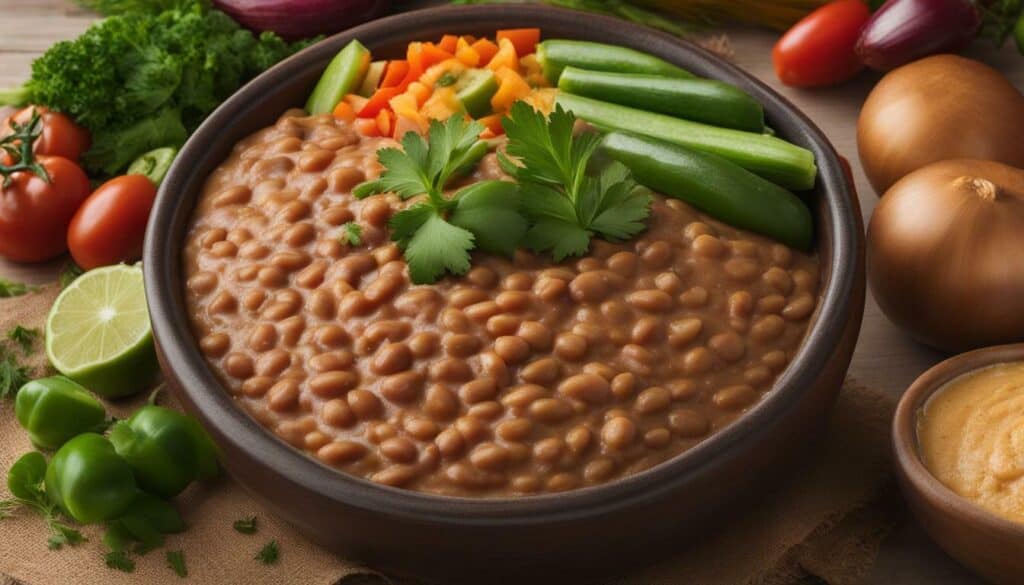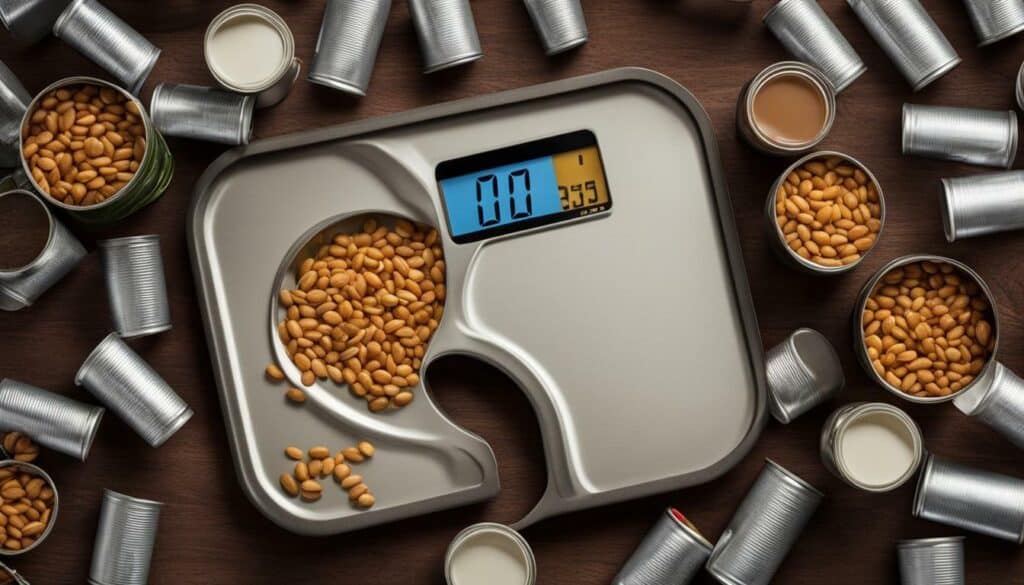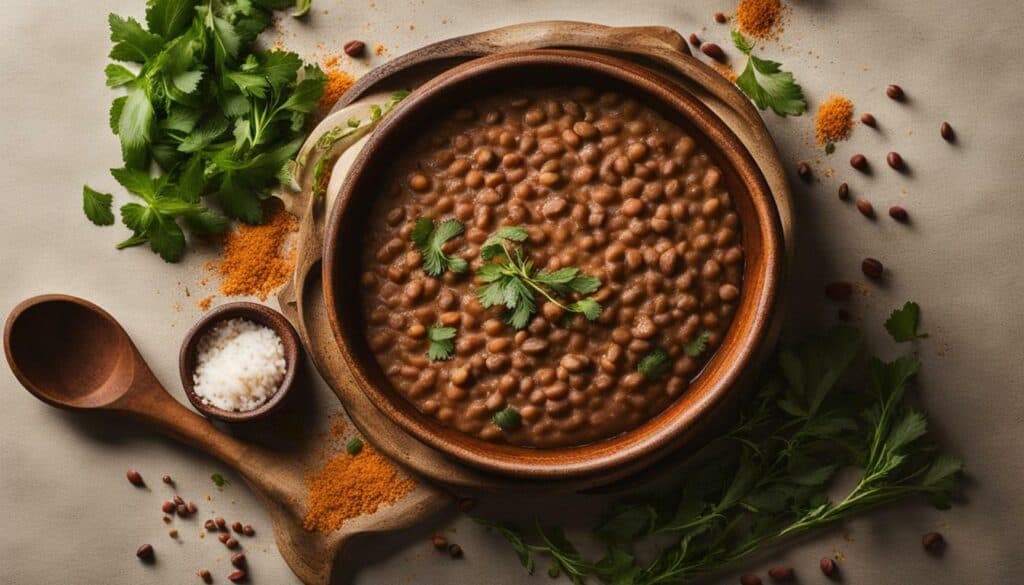Refried beans are a versatile dish that is enjoyed in Tex-Mex cuisine, but understanding their nutritional profile is key to making informed dietary choices. Contrary to popular belief, refried beans are not deep-fried but rather cooked pinto beans that are pan-fried in lard and salt. They can also be cooked with red kidney beans or black beans and different seasonings.
Refried beans are rich in vitamins, minerals, and fiber, which are beneficial for heart and digestive health. They contain magnesium that may help reduce blood pressure levels and iron that supports blood production and immune health. However, lard, the primary ingredient in most refried beans, is high in fat and calories and may not be suitable for those looking to cut their calorie or saturated fat intake. Some refried beans are made with plant-based oils like olive oil, which are lower in saturated fat.
Additionally, refried beans may have potential health benefits such as improving heart health, stabilizing blood sugars, improving gut health, and fighting disease. However, depending on the cooking method, refried beans may hinder weight loss, increase cholesterol levels, and raise blood pressure. It is important to be mindful of portion sizes and choose low-fat or fat-free versions when consuming refried beans.
Adding spices and seasonings like chili powder, cumin, garlic powder, onion powder, smoked paprika, oregano, and lime or lemon juice can enhance the flavor of refried beans.
Refried beans can be a nutritious addition to a balanced diet when prepared using healthier ingredients and consumed in moderation.
Key Takeaways:
- Refried beans are made from cooked pinto, red kidney, or black beans that are pan-fried in lard or other oils.
- They are rich in vitamins, minerals, and fiber, which are beneficial for heart and digestive health.
- Refried beans can provide magnesium and iron, supporting blood pressure regulation, blood production, and immune health.
- However, lard, a common ingredient in refried beans, is high in fat and calories, so portion control is essential.
- Choosing low-fat or fat-free versions and adding spices can enhance the nutritional value and flavor of refried beans.
What Are Refried Beans Made Of?
Refried beans are traditionally made by pan-frying cooked pinto, red kidney, or black beans in lard or plant-based oils, along with seasonings for added flavor. Contrary to their name, refried beans are not actually fried twice, but rather cooked and mashed after being initially cooked. The name “refried” comes from the Spanish word “refritos,” which means well-fried. This cooking process gives refried beans their creamy texture and rich taste.
The main ingredient in traditional refried beans is lard, which is a type of animal fat. However, there are healthier alternatives available, such as using plant-based oils like olive oil or avocado oil instead of lard. These oils are lower in saturated fat and can provide a healthier option for those seeking to reduce their intake of saturated fats. Vegetarian refried beans omit lard altogether and use plant-based oils instead, making them suitable for individuals following a vegetarian or vegan diet.
Refried beans can be seasoned with various ingredients, such as garlic, onions, cumin, chili powder, and paprika, to enhance their flavor profile. These seasonings add a delightful blend of spices and create a savory taste that complements the beans’ natural flavors. Some people also enjoy adding a squeeze of lime or lemon juice for a touch of acidity.
Table: Different Varieties of Refried Beans
| Refried Bean Variety | Main Ingredients | Dietary Considerations |
|---|---|---|
| Traditional Refried Beans | Pinto Beans, Lard, Salt | Higher in saturated fat |
| Vegetarian Refried Beans | Pinto Beans, Plant-Based Oils, Seasonings | Suitable for vegetarian and vegan diets |
| Gluten-Free Refried Beans | Pinto Beans, Plant-Based Oils, Seasonings | Does not contain gluten |
| Low-Fat Refried Beans | Pinto Beans, Plant-Based Oils, Seasonings | Lower in saturated fat |
When choosing refried beans, consider your dietary preferences and specific dietary considerations. Opting for vegetarian, gluten-free, or low-fat varieties can be a healthier choice depending on your nutritional needs. It’s always important to read the labels and check the ingredients to ensure you’re making an informed decision.
The Nutritional Value of Refried Beans
Refried beans are packed with essential nutrients, including fiber, protein, and carbohydrates, making them a nutritious addition to your diet. Let’s take a closer look at the nutritional content of refried beans:
High Fiber: One cup of refried beans contains about 14 grams of dietary fiber, which is approximately half of the recommended daily intake for adults. Fiber is crucial for maintaining a healthy digestive system and can help prevent constipation.
Protein: Refried beans are a good source of plant-based protein. One cup of refried beans provides around 15 grams of protein, which is important for muscle growth and repair.
Carbohydrates: Refried beans are relatively high in carbohydrates, with one cup containing about 45 grams. Carbohydrates are the body’s main source of energy, making refried beans a great option for fueling your body throughout the day.
To give you a better overview of the nutritional content of refried beans, I have created a table below:
| Nutrient | Amount per 1 cup (approximately 240g) |
|---|---|
| Calories | 220 |
| Total Fat | 9 grams |
| Saturated Fat | 2 grams |
| Cholesterol | 0 grams |
| Sodium | 580 milligrams |
| Carbohydrates | 45 grams |
| Dietary Fiber | 14 grams |
| Protein | 15 grams |
Remember, these values may vary depending on the brand and recipe used to prepare the refried beans. It’s always a good idea to check the nutrition label for accurate information.
Next, we’ll explore the potential health benefits of incorporating refried beans into your diet and discuss any potential drawbacks to be aware of.
Health Benefits of Refried Beans
Incorporating refried beans into your diet can offer a range of health benefits due to their nutrient-rich composition. These delicious legumes are packed with essential vitamins, minerals, and fiber that can support your overall well-being.
Refried beans contain a significant amount of fiber, which aids in digestion and helps maintain a healthy weight. Fiber also helps stabilize blood sugars, making refried beans an excellent choice for individuals with diabetes or those looking to manage their blood sugar levels.
Furthermore, refried beans are a good source of folate, iron, and magnesium. Folate is essential for cell growth and development, while iron plays a crucial role in blood production and immune health. Magnesium, on the other hand, helps regulate blood pressure levels, promoting heart health.
Additionally, refried beans are rich in antioxidants that can protect your body against harmful free radicals and reduce the risk of chronic diseases. These antioxidants, coupled with their high fiber content, contribute to improved gut health and regular bowel movements.

| Nutrient | Amount per 1/2 cup serving |
|---|---|
| Calories | 120 |
| Protein | 7 grams |
| Fiber | 6 grams |
| Fat | 5 grams |
| Iron | 10% of the Daily Value (DV) |
| Magnesium | 8% of the DV |
While refried beans offer numerous health benefits, it’s important to consider your specific dietary needs. Some variations may hinder weight loss efforts or increase cholesterol levels due to the high-fat content in traditional recipes that utilize lard. Opting for low-fat or fat-free versions can help mitigate these concerns.
Moreover, exploring different cooking methods and incorporating flavorful spices like chili powder, cumin, and garlic powder can enhance the taste of refried beans without compromising their nutritional value.
By understanding the health benefits and potential drawbacks, you can make informed choices when including refried beans in your diet. Remember to practice portion control and opt for healthier preparations to maximize the nutritional value of this Tex-Mex favorite!
Potential Drawbacks of Refried Beans
While refried beans offer numerous health benefits, it’s important to be aware of potential drawbacks that may affect certain individuals. One potential drawback is that refried beans, particularly traditional recipes made with lard, can hinder weight loss efforts. Lard is high in fat and calories, which can contribute to weight gain when consumed in excess. If you’re trying to lose weight, it may be beneficial to choose low-fat or fat-free versions of refried beans or consider other sources of lean protein.
Another potential drawback of refried beans is their impact on cholesterol levels. Traditional refried beans made with lard may contain high levels of saturated fat, which can increase bad cholesterol (LDL) levels. High LDL cholesterol levels are associated with an increased risk of heart disease. For individuals with high cholesterol or a history of heart disease, choosing refried bean varieties made with healthier fats, such as plant-based oils like olive oil, can be a better option.
In addition, the sodium content of refried beans can be a concern for those with high blood pressure. Many commercially prepared refried beans can be high in sodium, which may raise blood pressure levels. Consuming excessive amounts of sodium can contribute to hypertension and other cardiovascular conditions. Opting for low sodium or reduced-sodium versions of refried beans, or making your own at home with minimal salt, can help mitigate this potential drawback.
Table: Nutritional Comparison of Traditional Refried Beans vs. Low-Fat Refried Beans
| Nutrient | Traditional Refried Beans (1 Cup) | Low-Fat Refried Beans (1 Cup) |
|---|---|---|
| Calories | 293 | 225 |
| Total Fat (g) | 13.8 | 3.9 |
| Saturated Fat (g) | 3.6 | 0.6 |
| Sodium (mg) | 701 | 426 |
| Protein (g) | 14.5 | 14.2 |
| Dietary Fiber (g) | 8.4 | 9.3 |
As shown in the table above, low-fat refried beans generally have fewer calories and less fat, especially saturated fat, compared to traditional refried beans. They also tend to have slightly lower sodium content, which can be advantageous for individuals watching their sodium intake. However, it’s important to note that nutritional values may vary depending on the brand and preparation method, so always check the nutritional label for accurate information.
In conclusion, while refried beans offer several health benefits, it’s crucial to be mindful of potential drawbacks, such as hindering weight loss, increasing cholesterol levels, and raising blood pressure. Individuals with specific dietary goals or health conditions should consider low-fat or fat-free versions of refried beans and monitor their portion sizes. By making informed choices and incorporating refried beans in moderation as part of a balanced diet, you can enjoy their nutritional benefits while minimizing potential drawbacks.

By making simple modifications to your cooking methods and ingredient choices, you can enjoy refried beans as part of a healthy and balanced diet. Here are some tips for preparing refried beans in a nutritious way:
Choose healthier ingredients:
- Opt for low-fat or fat-free refried beans to reduce your intake of saturated fat and calories.
- Consider using plant-based oils like olive oil instead of lard for a healthier fat option.
- Add extra vegetables like bell peppers, onions, or tomatoes to boost the nutritional value of your refried beans.
- Experiment with different spices and seasonings to add flavor without relying on excessive salt.
Practice portion control:
While refried beans can be a nutritious addition to your diet, it’s important to be mindful of portion sizes. Stick to a reasonable serving size to avoid consuming excess calories and to maintain a balanced diet. One serving of refried beans is typically around 1/2 cup, so measure your portions accordingly.
Try different cooking methods:
Traditional refried beans are pan-fried in lard, but there are alternative cooking methods that can reduce the fat content. Consider baking or air frying your beans for a healthier option. By using less fat or oil or omitting it altogether, you can still achieve a delicious and satisfying dish.
By following these simple tips, you can enjoy refried beans that are not only delicious but also better for your overall health. Remember to prioritize quality ingredients and portion control to make the most out of this nutritious Tex-Mex staple.

Elevate your refried bean dishes with a range of aromatic spices and seasonings to create a tantalizing flavor experience. Spices not only add depth and complexity to your refried beans but also provide additional health benefits. Here are some popular spices and seasonings to try:
- Chili Powder: Sprinkle some chili powder into your refried beans for a spicy kick. It adds a smoky flavor and pairs well with other spices.
- Cumin: Add a hint of earthiness to your refried beans with ground cumin. It complements the creaminess of the beans and adds a warm, nutty flavor.
- Garlic Powder: Enhance the savory taste of refried beans by incorporating garlic powder. It adds a delicious depth that complements the beans’ natural flavors.
- Onion Powder: For an extra layer of sweetness and aroma, sprinkle some onion powder into your refried beans. It adds a subtle but delightful taste to the dish.
- Smoked Paprika: If you enjoy a smoky flavor, consider adding smoked paprika to your refried beans. It imparts a distinct smokiness that pairs well with the beans’ creamy texture.
- Oregano: The addition of oregano brings a touch of herbaceousness to your refried beans. It provides a fresh and vibrant flavor that harmonizes with the other seasonings.
- Lime or Lemon Juice: Squeeze some lime or lemon juice over your refried beans to add a refreshing tang. It brightens the flavors and cuts through the richness of the beans.
Experiment with different combinations and amounts to find the perfect balance of flavors that suit your taste preferences. Remember to adjust the seasoning according to the size of your serving. You can also garnish your refried beans with fresh cilantro, chopped green onions, or a dollop of sour cream for added freshness and creaminess.
With these spices and seasonings, you can transform a simple dish of refried beans into a culinary delight that will impress your family and friends. Enjoy the burst of flavors as you savor each spoonful!
Table: Common Spices and Seasonings for Refried Beans
| Spice/Seasoning | Taste Profile | Pairing Suggestions |
|---|---|---|
| Chili Powder | Spicy, smoky | Ground cumin, garlic powder |
| Cumin | Earthy, nutty | Chili powder, garlic powder |
| Garlic Powder | Savory, aromatic | Onion powder, smoked paprika |
| Onion Powder | Sweet, aromatic | Garlic powder, smoked paprika |
| Smoked Paprika | Smoky, rich | Chili powder, garlic powder |
| Oregano | Herbaceous, fresh | Garlic powder, lime or lemon juice |
| Lime or Lemon Juice | Tangy, bright | Garlic powder, cumin |

When purchasing refried beans, it’s important to select options that align with your dietary goals, such as low-fat or fat-free versions. Traditional refried beans are typically made with lard, which is high in fat and calories. However, there are healthier alternatives available that can still satisfy your cravings for this delicious Tex-Mex dish.
Low-fat refried beans are a great choice for those looking to reduce their fat intake. These beans are made with less oil or lard, resulting in a lower fat content without compromising on flavor. They are still rich in essential nutrients and can be enjoyed as a nutritious addition to your meals.
Fat-free refried beans are another option to consider. These beans are made without any added fats, making them a lighter choice for those watching their calorie intake. They are lower in fat and calories while still providing you with the same great taste and texture of traditional refried beans.
When preparing your refried beans, you can also incorporate healthier ingredients like olive oil, which is lower in saturated fat compared to lard. Adding spices and seasonings like chili powder, cumin, garlic powder, onion powder, smoked paprika, oregano, and a squeeze of lime or lemon juice can further enhance the flavor without adding unnecessary fats or calories.
Remember, moderation is key when consuming refried beans. While they offer numerous health benefits, they can also hinder weight loss if consumed in excess. Be mindful of portion sizes and balance your meal with other nutritious components. As always, consult with a healthcare professional or registered dietitian to determine the best dietary choices for your specific needs and goals.
| Refried Beans | Calories (per 1/2 cup) | Total Fat (g) | Saturated Fat (g) |
|---|---|---|---|
| Traditional | 184 | 10 | 4 |
| Low-Fat | 115 | 2 | 0 |
| Fat-Free | 100 | 0 | 0 |
Table: Comparison of nutritional values in traditional, low-fat, and fat-free refried beans per 1/2 cup.
Conclusion
Understanding the nutritional information and health benefits of refried beans can help you make informed decisions about incorporating them into your diet for a balanced and healthy lifestyle.
Refried beans are a popular dish in Tex-Mex cuisine and are cooked pinto beans that are pan-fried in lard and salt. However, they can also be cooked with red kidney beans or black beans and different seasonings.
Despite their cooking method, refried beans are rich in vitamins, minerals, and fiber, which are beneficial for heart and digestive health. They contain magnesium that may help reduce blood pressure levels and iron that supports blood production and immune health.
It is important to note that lard, the primary ingredient in most refried beans, is high in fat and calories and may not be suitable for those looking to cut their calorie or saturated fat intake. However, some refried beans are made with plant-based oils like olive oil, which are lower in saturated fat. Additionally, depending on the cooking method, refried beans may hinder weight loss, increase cholesterol levels, and raise blood pressure. Therefore, it is crucial to be mindful of portion sizes and choose low-fat or fat-free versions when consuming refried beans.
To enhance the flavor of refried beans, you can add spices and seasonings like chili powder, cumin, garlic powder, onion powder, smoked paprika, oregano, and lime or lemon juice. These additions can make your refried beans even more delicious and enjoyable.
Overall, refried beans can be a nutritious addition to a balanced diet when prepared using healthier ingredients and consumed in moderation. By considering their nutritional information and potential health benefits, you can make the best choices for your well-being.
FAQ
Q: Are refried beans deep-fried?
A: Contrary to popular belief, refried beans are not deep-fried. They are cooked pinto beans that are pan-fried in lard or other oils.
Q: What are refried beans made of?
A: Refried beans are made primarily of cooked pinto beans that are pan-fried with lard and salt. They can also be made with red kidney beans or black beans and various seasonings.
Q: Are refried beans healthy?
A: Refried beans can be a nutritious addition to a balanced diet. They are rich in vitamins, minerals, and fiber, which are beneficial for heart and digestive health. However, they are high in fat and calories due to the lard used in traditional recipes.
Q: Can refried beans help with weight loss?
A: Depending on the cooking method, refried beans may hinder weight loss due to their high fat and calorie content. However, choosing low-fat or fat-free versions and practicing portion control can make them a more suitable option for weight management.
Q: Do refried beans raise cholesterol levels?
A: Refried beans can increase cholesterol levels due to their high fat content. It is important to consider the overall fat intake and choose low-fat or fat-free versions if you are concerned about cholesterol.
Q: How can I enhance the flavor of refried beans?
A: You can enhance the flavor of refried beans by adding spices and seasonings such as chili powder, cumin, garlic powder, onion powder, smoked paprika, oregano, and lime or lemon juice.
Q: Are there healthier versions of refried beans available?
A: Yes, there are low-fat and fat-free versions of refried beans available in the market. These options can be lower in saturated fat and calories compared to traditional recipes made with lard.
Q: How should I choose the right refried beans?
A: When selecting refried beans, look for low-fat or fat-free varieties. Read the nutrition labels to compare the fat and calorie content of different brands.
Q: Are refried beans suitable for a vegetarian or gluten-free diet?
A: Refried beans can be suitable for vegetarian diets. However, it is important to read the label and ensure that no lard or animal-based ingredients are used. Some refried beans are also gluten-free, but it is advised to check the label for any potential gluten-containing additives.
Is Bush’s brand of refried beans a healthy choice?
Is Bush’s brand of refried beans a healthy choice? Many consumers wonder about the truth behind bush’s nutrition information. While refried beans can be a nutritious addition to a well-balanced diet, it’s important to examine the ingredients and serving sizes. Always consult the nutrition labels to make an informed decision about your dietary needs.





Leave a Reply